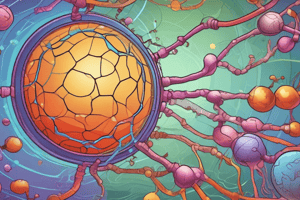Podcast
Questions and Answers
Anabolic pathways are synthetic pathways that produce cellular components. It usually involve a substantial increase in molecular order (and therefore a local decrease in entropy) and are ______ (energy-requiring).
Anabolic pathways are synthetic pathways that produce cellular components. It usually involve a substantial increase in molecular order (and therefore a local decrease in entropy) and are ______ (energy-requiring).
endergonic
Catabolic pathways are degradative pathways involved in the breakdown of cellular constituents. It typically involve a decrease in molecular order (increase in entropy) and are ______ (energy-liberating).
Catabolic pathways are degradative pathways involved in the breakdown of cellular constituents. It typically involve a decrease in molecular order (increase in entropy) and are ______ (energy-liberating).
exergonic
Life at the cellular level depends on a network of integrated and carefully regulated metabolic pathways, each contributing to the sum of activities that a cell must carry out. Metabolic pathways are of two general types Anabolic pathways (from the Greek prefix ana–, meaning “up”) – synthetic pathways that produce cellular components. Catabolic pathways (from the Greek prefix kata–, meaning “down”) – degradative pathways involved in the breakdown of cellular constituents. *Entropy is defined as a measure of randomness or disorder of a system. ATP.
Life at the cellular level depends on a network of integrated and carefully regulated metabolic pathways, each contributing to the sum of activities that a cell must carry out. Metabolic pathways are of two general types Anabolic pathways (from the Greek prefix ana–, meaning “up”) – synthetic pathways that produce cellular components. Catabolic pathways (from the Greek prefix kata–, meaning “down”) – degradative pathways involved in the breakdown of cellular constituents. *Entropy is defined as a measure of randomness or disorder of a system. ATP.
Chemotrophic Energy Metabolism Glycolysis and Fermentation Mitochondria as the ATP-generating Organelle Citric Acid Cycle Electro Transport: Electron Flow from Co-enzyme to Oxygen ATP Synthesis Life at the cellular level depends on a network of integrated and carefully regulated metabolic pathways, each contributing to the sum of activities that a cell must carry out. Metabolic pathways are of two general types Anabolic pathways (from the Greek prefix ana–, meaning “up”) – synthetic pathways that produce cellular components. Catabolic pathways (from the Greek prefix kata–, meaning “down”) – degradative pathways involved in the breakdown of cellular constituents. *Entropy is defined as a measure of randomness or disorder of a system. ATP.
Chemotrophic Energy Metabolism Glycolysis and Fermentation Mitochondria as the ATP-generating Organelle Citric Acid Cycle Electro Transport: Electron Flow from Co-enzyme to Oxygen ATP Synthesis Life at the cellular level depends on a network of integrated and carefully regulated metabolic pathways, each contributing to the sum of activities that a cell must carry out. Metabolic pathways are of two general types Anabolic pathways (from the Greek prefix ana–, meaning “up”) – synthetic pathways that produce cellular components. Catabolic pathways (from the Greek prefix kata–, meaning “down”) – degradative pathways involved in the breakdown of cellular constituents. *Entropy is defined as a measure of randomness or disorder of a system. ATP.
ATP Synthesis is carried out in the
ATP Synthesis is carried out in the
Flashcards are hidden until you start studying




